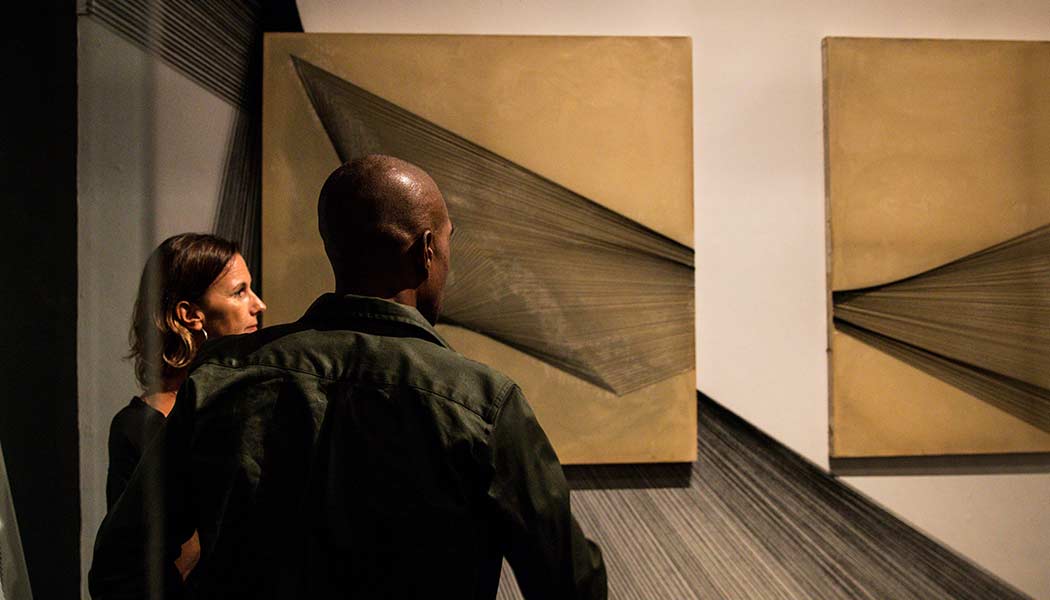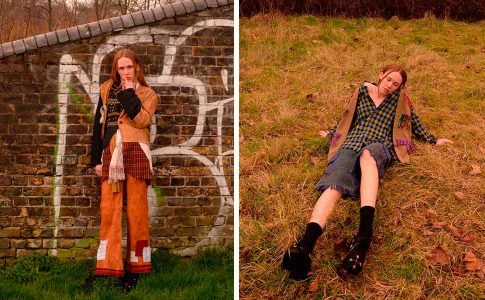Inside the strung out world of César Fernandez. Photos Jemma Scott and Kane Kennar. Words Ano Mac.
César Fernandez is a Spanish-born artist who takes a straight line and bends your mind around it. Quick with a smile and armed with a truckload of that amazing Iberian charm it is hard to believe he spends literally months of his life by himself sewing string onto canvases before coating the entire thing in fiberglass resin. The results project balance and purpose while retaining soft translucent properties overlayed with a wholly accessible beauty.
In his latest installation of pieces, César set out to immerse the observer, not only into his aesthetic world but also the Bali exhibition space where he interwove his works within an installation of complex compositions of thread, creating a large and complex matrix. The Yak caught up with him for some hard and fast questions.
César, can you tell us where you came up with the concept for your series ‘Linescapes’?
Linescapes is a collection that I created after an intense study around the emptiness in pictorial art. In my pieces I try to work with the simplicity of the line to generate a varied and complex structure, a series of paintings and installations that encompass an interactive geometric space where the viewer is left to interpret their own experience. Abstract and highly suggestive linear compositions enhance the use of line, and the concept of ‘less is more’ works perfectly in this exercise in combining the four elements predominantly used in my work – point, line, geometry and space. This has allowed me to elaborate and expand on my style and identity, managed with great care in modeling a plastic and aesthetic artistic expression. At the same time, a primordial part of my art is negative space; the presence of emptiness is the basis that unifies my work, which is why the installations are such a major part. To connect the viewer on a three-dimensional level creates rhythm and harmony between my pieces and the audience.
Who, or what, are the major influences behind your work?
I have a strong predilection for architectural figureheads like Frei Otto and Antoni Gaudí, these timeless figures are largely responsible for the direction my work is heading. However inspiration comes to me from many other aspects of my life, such as seeing my wife design her clothing collections, visiting cities, museums and meeting new artists, everything influences the way in which I work. One of the most beautiful things about being an artist is that you never stop learning, with this open state of mind we are able to seek, and find, inspiration in everyday banalities.
Can you describe the process for completing a canvas?
The process behind completing a canvas is, well … it’s complicated! To really break it down though, I suppose I divide it into three parts – idea, creation and finish. Conceptualising the idea is the most complicated part, it can take weeks until I’m satisfied with the ideal concept and idea. The creation of my work is solely the production. The fine threads that I hand-sew to the canvas definitely takes time, for me it has almost become a form of meditation. Depending on how the flattened geometric shape and the idea behind the work flow together, I’m usually sewing between a period of two weeks or two months. To complete a piece … just thinking about it gives me a migraine, no doubt it is the most technical part of my work. This is where I take fiberglass resin and catalyst adding them together, in the same way surfboard and boat builders do. If the amount of catalyst is at a higher percentage then there is a chemical and heat reaction with the resin and the picture burns and becomes unusable. However if the dosage is too small the resin does not crystallize, also making it unusable. There is a small threshold between the ideal aesthetic and complete ruin; after two months of hard work I pray for the latter! In turn, this process is incredible to work with and witness, it is the resin itself that allows me to create impasto textures and generate a whole range of tonalities.
Recently you created these spiderweb installations as part of the exhibition … why do you do that?
My installations are the continuation of my work, a very important part as it carries the art to another dimension. When I’m working on a canvas I usually only work two-dimensionally, however with the combination of the installation, the three dimensional use of space completely changes the perspective. At different standpoints the viewer is open to ambiguous interpretations of the art and are able to interact and connect through that space as well as the art pieces themselves.
I always try to work with this abstract visual perception in each of my exhibitions, as it offers a place to interact and engage. Personally I find it a lot more exciting than looking at a canvas screwed to the wall. I want to offer a greater interaction where each viewer experience is unique.
You have been in Bali now on and off for quite a few years, has that helped you as an artist?
The creative culture encompassing this island, and Canggu in particular, makes it an incredible place to work and grow as an artist. Bali is special in that it has a young, open-minded and creative community that really encourages you to push boundaries. I am very lucky that I have been able to surround myself with people I admire, such as the Gorrow family, Andrew Wellman, Crille Rask, Javier Soto and a long list of artists who, in their different disciplines, do incredible things.
Where is your art taking you?
My art has enabled me to travel and experience a respectable variety of places, meet a lot of creatively unique people and most importantly, it has taught me to relax and enjoy this absolute rollercoaster of life. There is no money that can buy this kind of experience, fellow artists will know what I mean … to be so immersed in an idea or project and then come out the other end months down the track with a finished piece is the most rewarding part.
Thanks for your time César.








































